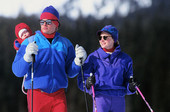
SATURDAY, Feb. 20 (HealthDay News) — Cold weather shouldn’t keep you from exercising outdoors.
“If you are concerned about hypothermia, you don’t need to be unless the temperatures are extreme,” Gary Sforzo, a professor of exercise and sports sciences at Ithaca College, said in a news release from the school.
“The body produces a lot of heat during exercise and when it produces heat, it pretty much diminishes any chance of hypothermia,” he explained. “The key is continuous exercise. If you go outdoors for a walk or run, just move continuously. Don’t stop for five or 10 minutes to talk to your neighbor. Hikers sometimes get into trouble if they stop for lunch. As long as you are moving, the muscles produce metabolic heat and that metabolic heat will keep you pretty warm, sometimes to the point where you need to remove clothing.”
Proper clothing is important. The layer next to your skin should be a synthetic material that transports perspiration away from the skin. Don’t wear cotton, which retains moisture. Your outer layer should be a windproof jacket.
“The danger zone is typically in the -20 to -30 windchill zone,” Sforzo said. “When the ambient temperature is in the single digits or below and you have wind, you can have some problems. When the ambient temperature gets to 20 below with even the slightest wind, then obviously hypothermia is a problem if you stand around. But in those conditions you are also looking at the potential of frostbite.”
To prevent frostbite, keep extremities covered with a hat, gloves and good footwear. To protect your nose, wear a scarf as high as possible on your face, Sforzo recommended.
He noted that the body adapts to cold temperatures, “so don’t wait until it is 5 degrees outside to have your first [exercise] session. When the body adapts, it will have a couple of different changes. It will shiver differently and it will more readily release hormones like epinephrine and thyroxine, which allow the body to produce heat more effectively in cold weather. Get used to the cold, and it will become more comfortable.”
More information
Princeton University has more about hypothermia and cold weather injuries.

